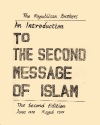The Scientific Phase of Religion
All forms of Religion, including the advanced monotheistic forms, like Judaism, Christianity, and Islam (in the form of its First Message), have up to now, presented only, the aspects of Religion which did not extend beyond faith and belief. Undoubtedly, faith and belief used to be sufficient for dealing with social and personal problems. But, in this age of ours, which has witnessed great scientific and technological leaps, and has been subjected to two great wars of cataclysmic dimensions and exposed to various political, ideological and philosophical upheaval, in this age of ours, faith and belief are no longer sufficient to solve the problems of contemporary man, or to set his troubled heart or puzzled mind to rest.
This state of affairs has faced Religion with a real challenge on the response to which depends the future of Religion and, in turn, the future of mankind on this planet Earth. This challenge to Religion has found expression in many forms. If one considers the scientific and technological leaps which established the triumph of science and made man a slave to the machine, then it becomes apparent that for Religion to stage a comeback, to play its roles as a liberating agent, it must be so “Scientific” (with a capital S) that it renders science, in the sense that we know now, unscientific, or at least pushes it from overstepping its limits where it is a harness to the service of man. This is, of course, necessary for putting the horse before the cart and releasing man from the chains which enslaved him to science and technology, so that he, once again, becomes the Master and not just a cog in a wheel.
Now, if one considers the potential for total annihilation, at our disposal, and the many psychological pressure to which contemporary man is subjected and if one takes into account the history of the two past world wars and the proliferation of local wars and conflicts which can possibly flare up into conflagration of global dimension, then it becomes apparent that the question of peace is a matter of “life and death” ... This means that for Religion to perform its function as a pacifying agent, it must be able to remove all causes and sources of friction and conflict.
On careful examination, one can see that external conflicts in the world at large are actually, projections and reflections of internal conflicts within each of us. So, to remove external causes of friction and conflict, it is necessary to remove internal ones. As we say this, we are not oblivious of the fact that sometimes the removal of internal causes of conflicts necessitates the removal of some external one. Indeed, the relation between the internal and external causes of friction is a dialectical one. But at this stage of human development, the removal of the internal causes is indeed the more important. So, for Religion to perform its role as a pacifying agent, it must be a “science of the self”, of say, a “Psychology” which analyzes problems, diagnoses and cures ills and facilitates the full development of the personality along both, the external and internal dimensions. In this way, internal conflicts are, initially, cooled down and finally, conquered. This, in turn, helps initially, in containing external conflicts and, ultimately, in avoiding them altogether.
The above-mentioned specifications, for Religion to stage a comeback to serve as an agent of liberation and an agent of pacification, are such that it must be so “scientific” that it surpasses science, as we know it now, and it must be a “science of the self.” These specifications are amply satisfied by the Second Message of Islam, while all other forms of Religion, including the advanced forms, Judaism, Christianity and the First Message of Islam, fall short of them.
This statement does not, in any way, mean that these forms of Religion are to be sent down the drain. In fact, it simply means that the Second Message of Islam by unmasking the scientific phase of Religion has succeeded in laying the solid foundations and paving the way for the realization of all the high moral, spiritual and intellectual ideals which were, in varying degrees, professed, though perhaps, not realized, by all those forms of Religion. In this sense, the Second Message of Islam, which represents the scientific phase of Islam, is the inheritor of all the intellectual and spiritual achievements of past and present generations, the world over, in all fields of art, literature, science, religion, etc...
As a conclusion to this section, it may be necessary to recall that we mentioned at the beginning of this section that all forms of Religion, including the advanced monotheistic forms, Judaism, Christianity and the First Message of Islam, did not extend beyond the limits of faith and belief which were no longer sufficient to answer the problems of modern man. But should we come to the Second Message of Islam we will find that faith and belief are just the start of an external voyage of discovery whose end is certainty. Certainly, in turn, leads to tranquility, equanimity and inner peace. The process whereby an individual climbs from faith and belief to certainty is summed up in what is called the “imitation of the Prophet” which was outlined in an earlier section. Indeed, the fact that the Second Message of Islam leads to certainty is what makes it, in the final analysis, represent the scientific phase of Islam.

